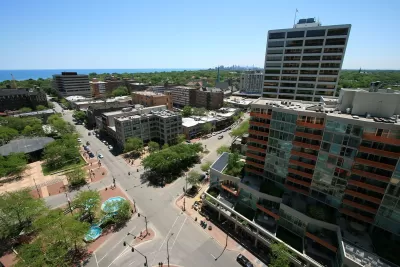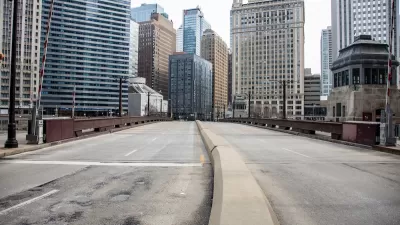As more workers move away from the central city due to high costs and remote work opportunities, companies that once relocated downtown are eyeing Chicago’s suburbs once again.

Chicago’s suburbs could be having a renaissance, writes Katharine Conlon. “From food giant Hillshire Brands to Motorola Solutions and in-flight WiFi provider Gogo, the past decade has brought a spate of relocations from the suburbs into the city, with the past two years of remote work pushing suburban office vacancy even higher, to a record 27% at the end of last year, according to JLL data.” Thanks to new work patterns spurred by the pandemic and rising downtown housing costs, however, the Chicago suburbs are seemingly making a comeback.
The traditional suburban form is changing, too. “Wendy Spreenberg, founder and president of YES! Your Exceptional Space, said Chicago suburbs are embracing the 15-minute city concept that emphasizes a decentralized local economy in which all necessary amenities are within a short walk, bike ride or public transit trip.”
As the article notes, “Some formerly downtown-only companies have already begun dipping their toes into suburban waters as workers begin transitioning back to the office, if only on a hybrid basis.”
According to Core Acquisitions Managing Principal Adam Firsel, “How the suburban market will shake out and how the new hybrid work landscape will impact decisions about location and footprints are open questions.” For now, “companies [are] still reluctant to commit to long-term leases or set square footage requirements.”
FULL STORY: Changing Minds on Restrictive Zoning: How to Unclog America’s Home Supply

Study: Maui’s Plan to Convert Vacation Rentals to Long-Term Housing Could Cause Nearly $1 Billion Economic Loss
The plan would reduce visitor accommodation by 25,% resulting in 1,900 jobs lost.

North Texas Transit Leaders Tout Benefits of TOD for Growing Region
At a summit focused on transit-oriented development, policymakers discussed how North Texas’ expanded light rail system can serve as a tool for economic growth.

Why Should We Subsidize Public Transportation?
Many public transit agencies face financial stress due to rising costs, declining fare revenue, and declining subsidies. Transit advocates must provide a strong business case for increasing public transit funding.

How to Make US Trains Faster
Changes to boarding platforms and a switch to electric trains could improve U.S. passenger rail service without the added cost of high-speed rail.

Columbia’s Revitalized ‘Loop’ Is a Hub for Local Entrepreneurs
A focus on small businesses is helping a commercial corridor in Columbia, Missouri thrive.

Invasive Insect Threatens Minnesota’s Ash Forests
The Emerald Ash Borer is a rapidly spreading invasive pest threatening Minnesota’s ash trees, and homeowners are encouraged to plant diverse replacement species, avoid moving ash firewood, and monitor for signs of infestation.
Urban Design for Planners 1: Software Tools
This six-course series explores essential urban design concepts using open source software and equips planners with the tools they need to participate fully in the urban design process.
Planning for Universal Design
Learn the tools for implementing Universal Design in planning regulations.
City of Santa Clarita
Ascent Environmental
Institute for Housing and Urban Development Studies (IHS)
City of Grandview
Harvard GSD Executive Education
Toledo-Lucas County Plan Commissions
Salt Lake City
NYU Wagner Graduate School of Public Service





























